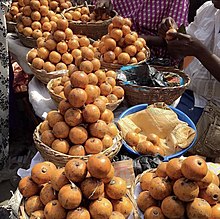mk
имиња во трошки

Gambeya albida, commonly known as white star apple,[1] is a forest fruit tree commonly found throughout tropical Africa.[3] It is closely related to the African star apple (Gambeya africana) which is also common throughout West Africa. Some schools of thought feel that they may just be a variety of the same species. Also in the family is the purple star apple (Chrysophyllum cainito).[3]
Amongst the Yoruba of Nigeria, it is called Agbalumo while it is called udala (udara) in the Igbo, Udari among the Efiks of Southern Nigeria with the usage of the latter term, coincidentally, also permeating across much of south-western Nigeria (i.e.,further east of Akoko-Ondo) the northern (Hausa-Fulani) parts of the country. One local enduring sobriquet is derived from the Yoruba agbalumo, i.e., ‘agbaluma,’ and is used in certain parts of Nigeria.
The inherent sweetness of a child (or person of especially-seasoned cognisance/age who otherwise displays certain amiability-desirable characteristics representative of children and/or well-adjusted adults, e.g., well-roundedness, joviality, unassuming understanding) has been likened to the fruit in Igbo, as ‘udala nwannu.’
Gambeya albida, commonly known as white star apple, is a forest fruit tree commonly found throughout tropical Africa. It is closely related to the African star apple (Gambeya africana) which is also common throughout West Africa. Some schools of thought feel that they may just be a variety of the same species. Also in the family is the purple star apple (Chrysophyllum cainito).
 African star apple
African star apple Amongst the Yoruba of Nigeria, it is called Agbalumo while it is called udala (udara) in the Igbo, Udari among the Efiks of Southern Nigeria with the usage of the latter term, coincidentally, also permeating across much of south-western Nigeria (i.e.,further east of Akoko-Ondo) the northern (Hausa-Fulani) parts of the country. One local enduring sobriquet is derived from the Yoruba agbalumo, i.e., ‘agbaluma,’ and is used in certain parts of Nigeria.
The inherent sweetness of a child (or person of especially-seasoned cognisance/age who otherwise displays certain amiability-desirable characteristics representative of children and/or well-adjusted adults, e.g., well-roundedness, joviality, unassuming understanding) has been likened to the fruit in Igbo, as ‘udala nwannu.’
Chrysophyllum albidum (en français la caïmite africaine) est un arbre tropical à feuillage persistant qui appartient à la famille des Sapotaceae. Il est connu au Bénin sous les noms vernaculaires suivants :
Son fruit est généralement appelé « pomme étoile blanche » ou « African star apple » en Anglais.
Chrysophyllum albidum est un arbre tropical à feuillage persistant. Il atteint des dimensions moyennes comprises entre 25 et 37 mètres de haut avec une circonférence de maturité variant en moyenne entre 1,5 et 8 mètres. Son bois est généralement cannelé, son écorce est mince, pâle au vert brunâtre, exsudant barre oblique blanche, latex gommeuse.
L’espèce dispose des feuilles simples, vert foncé dessus, fauve pâle en dessous quand il est jeune et blanc argenté dessous de maturité, de forme oblongue-elliptiques à obovales elliptiques allongées, 12-30 cm de long, 3,8 à 10 cm de large; sommet courtement acuminé, base cunéiforme ; latérales primaires nerfs largement espacés, 9-14 de chaque côté de la nervure médiane ; secondaire nervures latérales indistinctes ou invisible ; pétiole 1,7 à 4,2 cm de long.
Chrysophyllum albidum (en français la caïmite africaine) est un arbre tropical à feuillage persistant qui appartient à la famille des Sapotaceae. Il est connu au Bénin sous les noms vernaculaires suivants :
« Fon, Yorouba, Nago » : Azongogwe, Azonbobwe, Azonbébé, Vivignonmi. « Goun » : Azonvivo, Azonvovwe, Azonbebi.Son fruit est généralement appelé « pomme étoile blanche » ou « African star apple » en Anglais.
Chrysophyllum albidum – gatunek drzew należących do rodziny sączyńcowatych. Jest gatunkiem występującym w Afryce, głównie w północnej strefie przybrzeżnej Zatoki Gwinejskiej[3]. Drzewo to osiągające wysokość 25-37 m wykorzystywane jest jako źródło drewna używanego w budownictwie. Owoce C. albidum są jadalne[4].
Chrysophyllum albidum – gatunek drzew należących do rodziny sączyńcowatych. Jest gatunkiem występującym w Afryce, głównie w północnej strefie przybrzeżnej Zatoki Gwinejskiej. Drzewo to osiągające wysokość 25-37 m wykorzystywane jest jako źródło drewna używanego w budownictwie. Owoce C. albidum są jadalne.
Chrysophyllum albidum là một loài thực vật có hoa trong họ Hồng xiêm. Loài này được G.Don mô tả khoa học đầu tiên năm 1837.[1]
Chrysophyllum albidum là một loài thực vật có hoa trong họ Hồng xiêm. Loài này được G.Don mô tả khoa học đầu tiên năm 1837.
흰스타애플(-star apple, 학명: Chrysophyllum albidum 크리소필룸 알비둠[*])은 사포테과의 과일 나무이다.[2] 원산지는 가나, 가봉, 나이지리아, 베냉, 수단, 시에라리온, 우간다, 카메룬, 케냐, 코트디부아르, 콩고 민주 공화국 등 아프리카 열대 지역이다.[3]